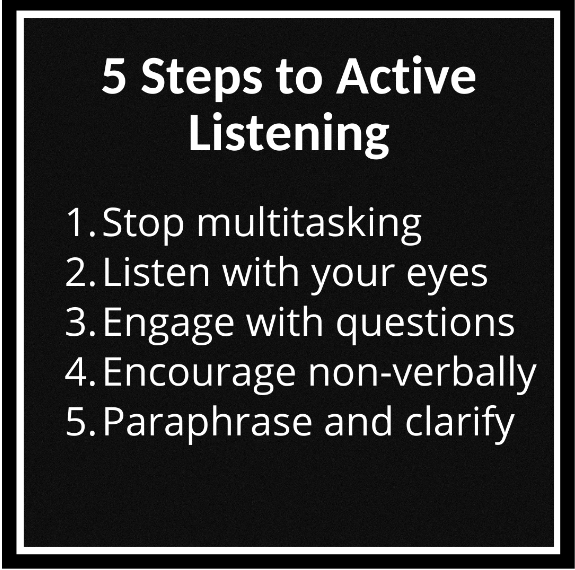Rehearsal Dropout and the Lost Art of Listening | Vol. 68
“The biggest communication problem is we do not listen to understand. We listen to reply.”
– Stephen R. Covey
Ever been in a conversation with someone and realized they stopped listening? You can see it in their eyes. They’ve gone inward and are waiting for their turn to talk. In improv comedy circles, this is sometimes called “rehearsal dropout.” Instead of listening for their cue, the cast member locks into their next joke at the expense of the skit. Rehearsal dropout derails comedy and conversations.
Few things make us feel less respected than being ignored. That’s likely why mountains of research connect active listening skills with effective sales, leadership, coaching, relationship building, and parenting. If you’d like to get better at any of those, listen up.
Active listening is a skill that can be honed in five steps. Remember these steps using the acronym “SLEEP” because, if you follow them, even the dullest discussion won’t lull you to SLEEP.

Five Steps to Active Listening
- Stop multitasking – We’re all basically programmed to glance at our phones when bored. When the conversation counts, put the phone away. Taking notes is an exception to the multitasking rule. That’s actually a plus. If you use a notes app on your phone, let them know that’s what you’re doing.
- Listen with your eyes – A lot of communication is non-verbal. A person’s posture, hands, and facial expressions all complement the story they tell. Besides, nothing says “I’m listening” like eye contact.
- Engage with questions – Great listeners interrupt. Yep, you heard that right. The right questions help the speaker unlock their topic. They move the dialogue along and open new avenues to explore. Just don’t hijack the conversation to talk about yourself.
- Encourage non-verbally – Whether or not you’re paying attention, the speaker is watching you. Are you nodding your head or fidgeting with your stuff? Are you leaning into the conversation or shifting back with your arms crossed? Just as you are aware of their body language, be cognizant of your own.
- Paraphrase and clarify – When the other person has finished sharing, confirm you heard them correctly. Summarize what you heard to make sure you got it right. It can also help clarify the next step. A client or coworker may have shared a challenge because they need your help. A spouse may have shared a problem because they need your sympathy. Even if you nailed everything up to now, you can still fail by misreading their intentions.
Almost 2,000 years ago, Epictetus advised, “We have two ears and one mouth so that we can listen twice as much as we speak.” In today’s hectic business environment, we’d be well-served to take heed.
One question to ponder in your thinking time: How can I be more present for the conversations that count?
Co-author of The One Thing & The Millionaire Real Estate Agent

Leave a Reply
You must be logged in to post a comment.